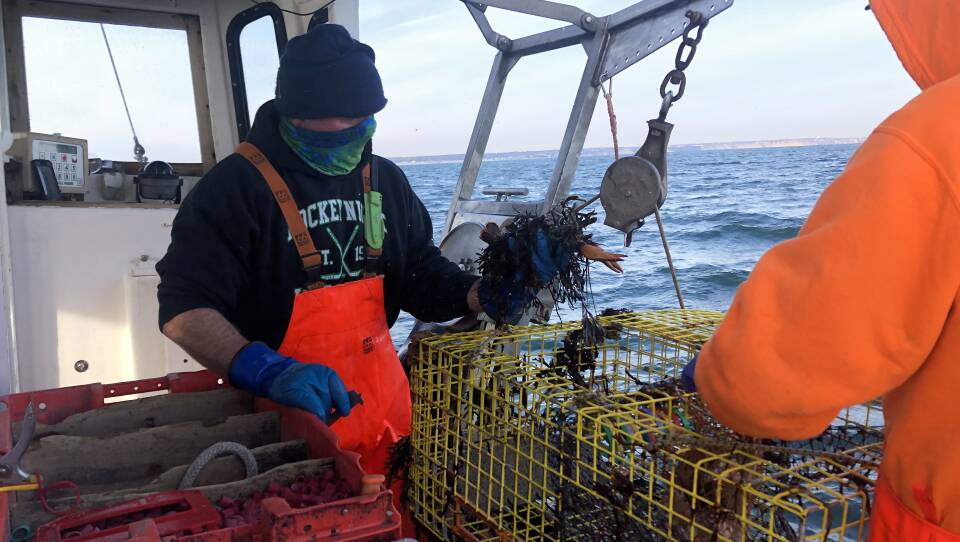The lobster industry could be getting a new sound.
On a cold January morning, a lobster trap sitting on a table at a manufacturing facility in Wareham is rhythmically beeping. Two final beeps have a special meaning.
“So that's the release confirmation,” explained Rob Morris, who sells acoustic release systems for the underwater technology company EdgeTech.
With this technology, lobstermen can send the acoustic signal from a phone app to a trap on the ocean floor. The signal triggers an airbag, with a line attached, to launch up to the surface, allowing the traps to be hauled in. These “ropeless” systems do away with the high number of vertical lines that run from buoys on the surface down to traps on the ocean floor.
Looking at this table, Morris sees the future of the fishery – and many conservationists share that hope. Ropeless fishing eliminates vertical lines in the water column that are blamed for around half of all reported North Atlantic right whale deaths.
But experts say the transition to ropeless is moving too slowly. By the time working gear can get into the boats of thousands of lobstermen across New England, it may be too late to save critically endangered right whales.
It’s being held up by technical, regulatory, and financial factors.
“If you talk to fishermen about ropeless fishing, one of the first questions out of their mouth is, ‘What is this going to cost?,’” said Mark Baumgartner, a marine ecologist at the Woods Hole Oceanographic Institution, and vice chair of the Ropeless Consortium. “To me, it's a 100 percent legitimate question. If this gear is going to be prohibitively expensive to them, adopting ropeless is essentially closing the fishery.”
Current EdgeTech systems could cost anywhere from $7,500 for one line of traps to $70,000 for a boat’s total gear conversion, according to Morris. Economies of scale are expected bring that down, but even so, it’s out of reach for nearly all fishermen.
Government funding will be essential, said Erica Fuller, a senior attorney with the Conservation Law Foundation.
“Our hope is that in the Biden administration, the urgency of right whales will translate to urgency in getting some of this funding available,” she said.
With funding, scientists and engineers can also resolve technical issues more quickly, particularly around gear marking.
“The gear location marking part of this is the ‘rate-limiting step,’” Baumgartner said. “It’s the thing that's keeping us from moving forward to some kind of commercial adoption.”
Gear marking apps do the job that buoys once did: they’re a visual cue so fishermen know where traps are located on the seafloor.
Currently, each of the handful of ropeless gear manufacturers uses its own app to mark the location of traps, and their apps don’t talk to one another. If there isn’t a shared system for viewing gear, lobstermen could unknowingly entangle their traps in other fishermen’s gear.
It’s a big sticking point for critics: ropeless technology will not be safe until gear marking is figured out.
“The technology is just like … we’re at the model T today, and people expect us to be at the Tesla tomorrow,” said Beth Casoni, executive director of the Massachusetts Lobstermen’s Association.
The association doesn’t support ropeless technology, at least not until a shared database that will allow fishermen to see traps on the seafloor is created. Manufacturers say they’re working on it. But, Casoni said, there’s still a long way to go to find out whether ropeless technology is viable for mass adoption.
“We need a large-scale, scientific, unbiased feasibility study on the whole thing,” Casoni said. “We need to put five boats out in a big square, fishing ropeless, mobile gear, and see what really happens.”
In Massachusetts, efforts are under way. The state recently announced a 12-month ropeless feasibility study to assess how well ropeless technology works, how to manage enforcement, and how it impacts marine life and the $600 million New England lobster industry.
But Casoni emphasized the hidden hurdle of ropeless technology: if lobstermen perceive that ropeless gear is dangerous, unreliable, or economically impractical, they won’t be willing to use it during closures, let alone during the rest of the year.
Conservationists like Mark Baumgartner are keenly aware of what could happen if these challenges aren’t overcome, and soon.
“The dual problems of the extinction of the right whale and incredibly difficult times – if not the extinction – of the trap fishing industry could be addressed simultaneously with a single solution,” he said, drumming the table to punctuate each word. “If we can get ropeless right.”
Experts say it will take at least five years to know whether ropeless is the answer, and in those five years, the thing that will make a difference is how bad we want it.





